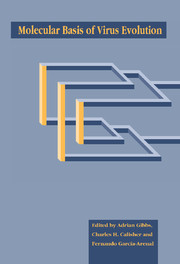Book contents
- Frontmatter
- Contents
- List of contributors
- Editors' preface
- Conference participants
- 1 Introduction and guide
- Part I The impact of viral diseases
- Part II Origins of viruses and their genes
- Part III Sources of virus variation
- Part IV Molecular interactions of viruses and their hosts
- Part V Viruses, hosts and populations
- Part VI Case studies of viral taxa; their systematics and evolution
- 18 Evolution of poxviruses and African swine fever virus
- 19 Molecular systematics of the flaviviruses and their relatives
- 20 Herpesviridae
- 21 Aphthovirus evolution
- 22 Evolution of the Bunyaviridae
- 23 Evolution of the tobamoviruses
- 24 The luteovirus supergroup: rampant recombination and persistent partnerships
- 25 The evolution of the Reoviridae
- 26 Genetic variation and evolution of satellite viruses and satellite RNAs
- 27 Molecular evolution of the retroid family
- 28 Adaptation of members of the Orthomyxoviridae family to transmission by ticks Patricia
- 29 The Order Mononegavirales: evolutionary relationships and mechanisms of variation
- 30 The molecular evolution of the human immunodeficiency viruses
- 31 Molecular evolution of papillomaviruses
- 32 Molecular systematics of the Potyviridae, the largest plant virus family
- 33 Evolution of alphaviruses
- 34 Evolution of influenza viruses: rapid evolution and stasis
- Part VII Techniques for viral systematics
- Index
24 - The luteovirus supergroup: rampant recombination and persistent partnerships
Published online by Cambridge University Press: 04 May 2010
- Frontmatter
- Contents
- List of contributors
- Editors' preface
- Conference participants
- 1 Introduction and guide
- Part I The impact of viral diseases
- Part II Origins of viruses and their genes
- Part III Sources of virus variation
- Part IV Molecular interactions of viruses and their hosts
- Part V Viruses, hosts and populations
- Part VI Case studies of viral taxa; their systematics and evolution
- 18 Evolution of poxviruses and African swine fever virus
- 19 Molecular systematics of the flaviviruses and their relatives
- 20 Herpesviridae
- 21 Aphthovirus evolution
- 22 Evolution of the Bunyaviridae
- 23 Evolution of the tobamoviruses
- 24 The luteovirus supergroup: rampant recombination and persistent partnerships
- 25 The evolution of the Reoviridae
- 26 Genetic variation and evolution of satellite viruses and satellite RNAs
- 27 Molecular evolution of the retroid family
- 28 Adaptation of members of the Orthomyxoviridae family to transmission by ticks Patricia
- 29 The Order Mononegavirales: evolutionary relationships and mechanisms of variation
- 30 The molecular evolution of the human immunodeficiency viruses
- 31 Molecular evolution of papillomaviruses
- 32 Molecular systematics of the Potyviridae, the largest plant virus family
- 33 Evolution of alphaviruses
- 34 Evolution of influenza viruses: rapid evolution and stasis
- Part VII Techniques for viral systematics
- Index
Summary
Introduction
The evolutionary history of viruses, inferred from comparisons of genomic sequences, appears unlike that of most other life forms. Novel viruses seem often to arise through the conjunction of genes from very different viral lineages. Viruses with RNA genomes as well as viruses with DNA genomes have evolved in this way, and either homologous or non-homologous recombination may be involved. Botstein (1980) named this process modular evolution, and its importance is clear from evidence that, on several occasions, it has led to the evolution of new viral genera (Gibbs, 1987). However, little is known about the frequency of these events nor is it known if they occur in some pattern, and the interpretation of phylogenies disturbed by modular evolution is in its infancy.
In this chapter I present perhaps the first evidence of a pattern to viral modular evolution, and the first evidence of a connection between interviral gene transfer and an ecological interaction between viruses. This evidence comes from the luteovirus supergroup which consists of plant viruses with small messenger sense RNA genomes and icosahedral virions (Goldbach & Wellink, 1988; Martin et aL, 1990; Dolja & Koonin, 1991). Six viral groups and some ungrouped viruses belong to the supergroup (Brunt, Crabtree & Gibbs, 1990; Francki et ai, 1991). Many of the viruses are agriculturally important (Duffus, 1977; Matthews, 1991). The genomes of 17 of them have been completely sequenced. Analysis of this data shows the supergroup to consist of two main clusters that are in some ways only distantly related.
- Type
- Chapter
- Information
- Molecular Basis of Virus Evolution , pp. 351 - 368Publisher: Cambridge University PressPrint publication year: 1995
- 14
- Cited by



